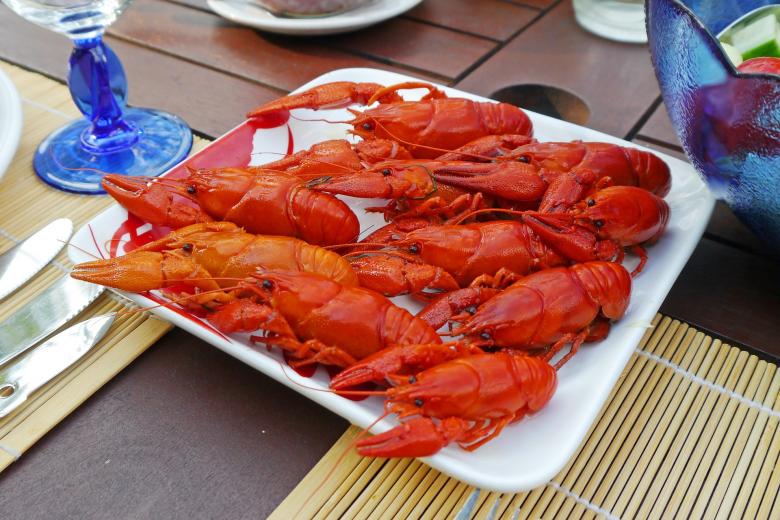The US lobster season is in full swing after Florida opened its fishing waters this summer. There are more happenings including the growing love for rock lobsters (spiny lobsters), the rarity of the blue lobster and the discovery of a new way to harvest shellfish as soon as they molt in Taiwan.
The gulf stream fans interest for spiny lobsters around the world
Can you eat spiny lobsters and are they really lobsters? A spot-check on menu costs of the crayfish in the US and worldwide shows that people definitely eat them with relish. Indeed, the Florida lobster season kicked off late July with a 48-hour spiny lobster fiesta.
Thriving mostly in the warm waters of Florida, US spiny lobsters measure just 40 cm long on average, but traverse warm oceans around the world.
In Britain, they are able to live in cold waters because the gulf stream off Florida in the South-east United States fans warm currents and extends to the North Atlantic Drift.
In Australia, they thrive on the western shores. They creep out to the shore at dusk and utilize their amazing big eyes to spot starfish and other small prey which they sup on. The crayfish is one of the most highly priced of all crustaceans in the Land Down Under, and costs $33 per kg and above.
In France, ‘langoustes’ as the locals call them, thrive off the Brittany coast and are somewhat expensive, fetching between $15.38 and $21.97 a kilo.
A parting shot: spiny lobsters resemble their crustacean namesakes but they are not actually true lobsters. They belong to the Decapoda reptantia group, have no claws and defend themselves with tails unlike their counterparts who use claws to face their enemies.
Soft-shell lobster industry about to change thanks to science
Elsewhere in Taiwan, scientists reported that a novel algorithm that predicts lobster molting timing will help Korea lobster farmers maximize harvests of newly molted soft-shell crustaceans.
In a country where soft-shelled lobsters is a major delicacy, it is touted that any aquaculture center with tens of thousands of lobsters can save 30% on time using the algorithm. While a regular shellfish costs an average NT$1000 ($31.57) per kg, that of soft-shelled crawfish calls forth NT$2000 ($63.16) a kilogram at a sushi restaurant.
The discovery is essential because during molting, lobsters are apt to consume one another. Hence, the new signaling system draws attention to the skin-shedding process in advance. Green, yellow and red signals on lobster cages indicate ‘get ready,’ ‘molting happening in the next 24 hours,’ and ‘time to harvest,’ respectively.
The system recommends harvests in half an hour of the alert to reduce losses due to cannibalism between the crustaceans.
Molting is a process where lobsters shed off their outer hard shell and regenerate a new soft exoskeleton. The process is so complete that it can even help regrow lost limbs and even eyes, a secret that makes lobsters some of the longest-lived animals. They can live between 140 to 200 years. Molting in adults occurs once every 12 or 24 months.
Why is blue Lobster currently so costly?
At $500 a kilo, buying blue lobster in Brittany, France is shell-shock in the pocket. Yet, people would do anything to lay hands on a creature whose spotting at sea is usually a once in-two-million occurrence.
In February this year, the BBC reported of an Irish fisherman who spotted a blue lobster and remarked on its vivid blueness. After returning it into the sea, he remarked that he had added it in his bucket list of weird sightings at sea.
The reason this rare lobster is blue is because it secretes more protein than other crustaceans. This changes its usual brown intonation to a bluish tinge.
Interesting general facts about lobsters
Size: According to the US Fisheries department (NOAA), US lobsters weigh an average of 45 pounds.
Migration: Lobsters are static but they seasonally travel some 225 miles or so. This is according to the statistics of a tagged crawfish that was registered in deep waters during autumn and recovered off Long Island, New York, in Summer.
Reproduction: Like humans, reproduction is a nine-month affair, during which female crawfish go under water to incubate at least 11,000 eggs per female for nine months.
Longevity: Lobsters have a lifespan of between 10 and 20 years, for spiny lobsters, and 140 to 200 years for claw lobsters.
Meanwhile, if you are after lobsters this season, whether it is US lobster, Canadian or Japanese lobster, European, or Australian, not to mention the Taiwanese soft-shell delicacy, it is high time you tried them. Prices of US and Canada live lobsters have gone down by 50% in five years, to settle at $7.50 a pound at retail.
